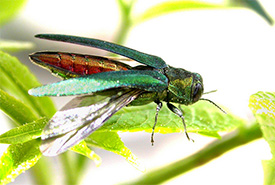
Emerald ash borer adult (Photo by by U.S. Department of Agriculture)
Emerald ash borer
The emerald ash borer (EAB) is a green beetle that was first discovered in North America in 2002. It is native to Asia and is a threat to the entire North American Fraxinus genus, commonly known as ash trees.
How is it identified?
Adult emerald ash borers are a dark metallic green colour. They have long narrow bodies that measure approximately 8 millimetres (o.33 inches) long and 1.5 millimetres (0.06 inches) wide. They have black eyes and flat heads.
Female beetles can lay over 100 eggs in their lifetime, either individually or in groups in the bark of ash trees. Fresh eggs are white in colour and turn amber. They hatch into creamy white larvae after approximately two weeks.
Where is it found?
In Canada the emerald ash borer beetles are found in Manitoba, Ontario, Quebec, New Brunswick and Nova Scotia, but EAB could devastate the ash population all across North America.
What does it threaten?
Ash trees are part of the urban and riparian forest. Since their arrival in North America, these beetles have killed tens of millions of ash trees. With no natural predators, EAB will greatly affect rural and urban forest. The loss of native ash trees could result in changes to water quality, soil nutrients and an increase in invasive plant species that may colonise the areas where ash has been killed.
How can it be controlled?
In Canada there are three kinds of insecticides that are recommended for trees that are infected with emerald ash borers. All are systemic insecticides that must be applied with a series of trunk injections or implants. The list of registered pesticides and their labels can be found by searching the Pest Management Regulatory Agency (PMRA) database.




